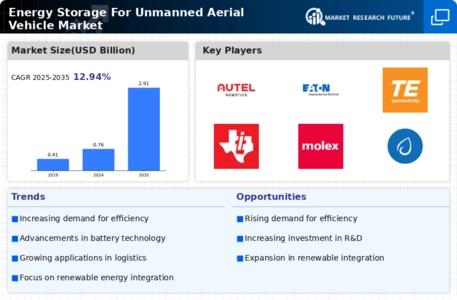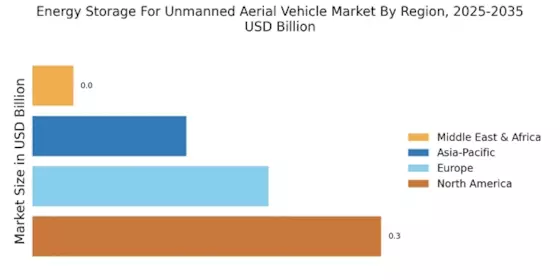Growing Demand for Drones in Various Sectors
The increasing utilization of unmanned aerial vehicles (UAVs) across diverse sectors such as agriculture, logistics, and surveillance is propelling the Energy Storage For Unmanned Aerial Vehicle Market. As industries seek to enhance operational efficiency, the demand for drones equipped with advanced energy storage solutions is surging. For instance, the agricultural sector is leveraging UAVs for precision farming, which requires reliable energy sources to ensure prolonged flight times. This trend is expected to drive the energy storage market, as UAVs are anticipated to require batteries with higher energy density and longer life cycles. The market for energy storage solutions in UAVs is projected to reach substantial figures, indicating a robust growth trajectory fueled by this demand.
Regulatory Frameworks Supporting UAV Operations
The establishment of regulatory frameworks that support UAV operations is a significant driver for the Energy Storage For Unmanned Aerial Vehicle Market. Governments are increasingly recognizing the potential of UAVs in various applications, leading to the formulation of policies that facilitate their integration into airspace. These regulations often emphasize safety and efficiency, which in turn necessitates the development of reliable energy storage systems. As regulatory bodies set standards for UAV performance, the demand for advanced energy storage solutions is likely to increase. This supportive environment is expected to foster innovation and growth within the energy storage market, as manufacturers seek to comply with evolving regulations.
Increased Investment in UAV Research and Development
The surge in investment directed towards research and development in the UAV sector is a key driver for the Energy Storage For Unmanned Aerial Vehicle Market. Governments and private entities are allocating substantial funds to explore innovative applications of UAVs, which necessitate advanced energy storage systems. This investment is likely to foster the development of next-generation batteries that can meet the specific demands of UAV operations. As the market evolves, the focus on enhancing energy efficiency and reducing operational costs will further stimulate growth in energy storage solutions tailored for UAVs. The anticipated increase in R&D spending is expected to yield significant advancements in energy storage technologies, thereby expanding the market.
Technological Innovations in Energy Storage Solutions
Technological advancements in energy storage solutions are significantly influencing the Energy Storage For Unmanned Aerial Vehicle Market. Innovations such as lithium-sulfur and solid-state batteries are emerging, offering higher energy densities and improved safety profiles compared to traditional lithium-ion batteries. These advancements are crucial for UAV applications, where weight and efficiency are paramount. The introduction of these cutting-edge technologies is likely to enhance the performance of UAVs, enabling longer flight durations and greater payload capacities. As a result, the energy storage market for UAVs is expected to witness a notable increase, with projections indicating a compound annual growth rate that reflects the growing integration of these technologies.
Rising Environmental Concerns and Sustainability Initiatives
Growing environmental concerns and the push for sustainability are driving the Energy Storage For Unmanned Aerial Vehicle Market. As industries strive to reduce their carbon footprints, the demand for eco-friendly UAVs powered by renewable energy sources is increasing. Energy storage systems that can efficiently harness solar or wind energy for UAV operations are becoming more prevalent. This shift towards sustainable practices is likely to encourage the development of energy storage solutions that align with environmental goals. The market is expected to respond positively to these trends, with projections indicating a rise in the adoption of energy storage technologies that support sustainable UAV operations.


















Leave a Comment